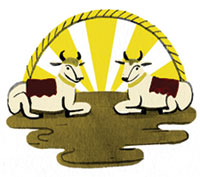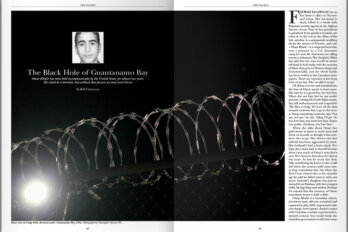It’s a few hours after sunrise, but the grey sky in Buffalo, New York, refuses any light, making the crushed Canadian tallboys and the stale water sheeting the concrete concourse around the First Niagara Center all the more bleak and more Buffalonian. Last night, the venue’s usual tenants, the NHL’s Sabres, took a 5–3 beating at the hands of the Pittsburgh Penguins, and the cleanup of streamers and stages is proceeding at a crawl.
Tonight the arena belongs to hockey’s menacing older brother, professional lacrosse. The Toronto Rock’s plain white rental bus rolls up to a loading dock at the rear of the arena, making an early start for a Saturday tilt against the team’s National Lacrosse League rivals, the Buffalo Bandits. The Rock’s imposing captain, Colin Doyle, unloads his gear and makes his way to the converted hockey floor for a shootaround inside the cavernous room. Sabres pennants hang from the rafters, and photos of the team’s stars line the mezzanine. It’s the same story in the Rock’s home arena, the Air Canada Centre, which is permanently adorned with Maple Leafs iconography. In the NLL, having the home field isn’t much of an advantage, the teams’ status as interlopers in these halls of hockey always looming.
Doyle, now sitting on the Sabres’ home bench and dodging errant balls as his fellow players warm up, is the face of the Rock franchise and the biggest name in the NLL, the sport’s pre-eminent professional organization. The Kitchener, Ontario, native has won an astonishing six championships with the Rock and starred in his own episode of MTV’s Cribs. Stardom in the NLL, though, is relative, and nowhere near as lucrative as in the NHL. The average lacrosse player makes $16,250 versus hockey’s $2.45 million (all figures US). Doyle, like most of his teammates, plays in multiple leagues year-round to patch together a living in the sport. Sometimes, he supply-teaches. A particularly brutal fight with Boston Blazers defenceman Paul Dawson has attracted more than 23,000 views on YouTube, where the most popular comment is “OMG Colin Doyle is my math teacher!! lmfao!!”
Sacred Cows
Where bulls are gods—and formidable adversaries
Andrea Wan
Spain’s 600-year-old bullfighting tradition came to an end in Catalonia in a final match on September 25, 2011, two years after a man was gored to death. Bullfighting is decried as cruel to the animal, but the sport persists in India, where the Hindu majority considers cattle sacred beasts. Jallikattu (“taming the bull”) draws thousands of spectators during the pongal winter harvest festival in Tamil Nadu to watch competitors wrestle bulls with their bare hands under banners that announce, “These bulls are our Gods.” The Supreme Court of India recently rejected a petition from the Animal Welfare Board to restrict Jallikattu, which is held up by fans as a symbol of “bravery and culture.” Since no weapons are used and the bull is not slain, human competitors are far more likely to be injured than the bovines.
—Isabel Slone
Still, NLL teams play in front of raging, fanatical crowds, and can pack the same arenas as the NHL: the Calgary Roughnecks share the Saddledome with the Flames, while New York’s former team, the Titans, held games at Madison Square Garden. But unlike in the NHL, the NLL’s nine teams depend on old-fashioned gate and merchandise for revenue.
“It’s what I imagine hockey was like fifty years ago when I hear stories about the Original Six,” says Doyle, remarking on the value of a sport that “isn’t trying to sell you anything” beyond a monster live spectacle and maybe a jersey on your way out. With just a handful of televised games every year, the NLL has yet to tap in to the broadcast money that has permanently altered the culture of every other professional league with sudden, massive, and often unmanageable influxes of cash, turning working athletes into celebrities with superstar egos.
“The Leafs, like it or not, can play awful hockey for as many years as they want,” continues Doyle. “In lacrosse, we have the sense that if we don’t play hard and put on a good show, people will stop coming.” The sport faces a Catch-22. More money would allow Doyle to focus on a single team year-round, and it would improve the game’s overall quality by funding player development. It could also spoil a league currently positioned somewhere between the grandiose, big-ticket spectacle of professional hockey and the gritty charm of a well-executed backyard wrestling round robin.
By the time the Rock is warmed up and ready to play, the First Niagara Center has been transformed into a full-blown house of lacrosse worship, draped in banners and Bandit photos. The nearly sold-out crowd of 17,322 is a sea of the home team’s black and orange. Below the press box, two Rock fans settle into their seats, proudly sporting Doyle jerseys. Buffalo scores the first goal, and the crowd explodes as if it’s the Stanley Cup finals. The fans keep up the bellowing through sixty minutes of playing time. It’s not hard to imagine lacrosse going mainstream—or what a new TV deal, some smart marketing, and more word of mouth could do for the game.
The crowd grows quieter when the Rock pulls ahead in the second half. Eventually, the Bandits topple in a lopsided 15–9 loss. Fans stream out of the centre, buoyed by the excitement of a major sporting event that somehow feels untainted by ego and money. “The heart and soul of this league is that we really enjoy that we can do this, and we don’t want it taken away from us,” Doyle said before the game. “If it was, we’d be very disappointed. So let’s not fuck it up.”
A few weeks later, the star player is at work in the sleepy white-bread town of Oakville, Ontario, coaching lacrosse camp at the Glen Abbey Community Centre and trying to get fifty kids to sit still and finish their pizza. “This is grassroots stuff for lacrosse,” he says between bites. “Not just important for the Rock, but for the game in general.”
When he blows his whistle, the kids snap to attention. He addresses them all, even the six-year-olds drowning in their goalie pads, as “gentlemen.” His reverence for the sport—for its history as an Aboriginal tradition dating back centuries, and for those who play it—is contagious. He pulls a pint-sized forward aside. “You’ve got work to do, big guy,” he says, before tweaking the kid’s grip slightly and sending him running off into a tiny, churning lacrosse melee.
This appeared in the March 2013 issue.




